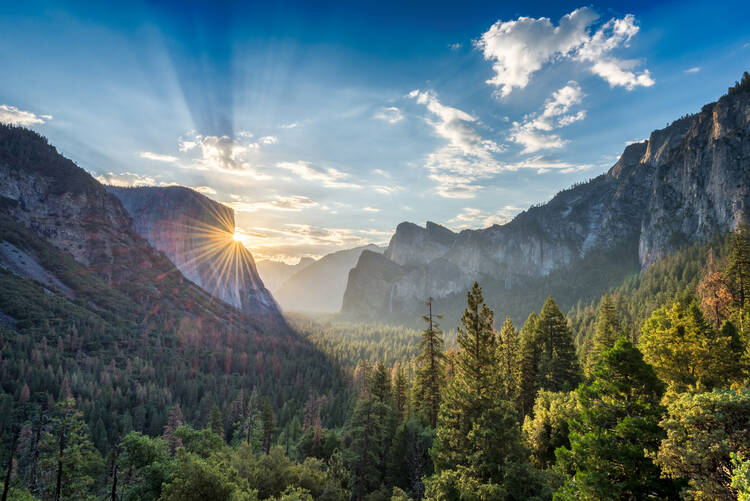A long white beard. A golden throne among clouds. A round and rosy face.
Until I started college (yes, college) this was how I imagined God. Consciously or not, my version of God had the same descriptors a child would use to imagine Santa Claus—minus the gift-giving, plus a whole lot of moral judgment. Then one retreat program made me rethink my vision.
During my time at Boston College, I was involved in an undergraduate retreat program called Kairos. The student leaders of the program undergo eight weeks of spiritual formation in preparation for the retreat weekend. It was during those weeks of formation, as I prepared to lead the Kairos retreat during my sophomore year, that I was asked the question: What is your image of God? And for the first time, I truly thought about the answer.
While I had interrogated my relationship with God during my Jesuit high school years and in my early undergraduate studies, I had never before questioned my default image of God as the big man in the sky.
In the week leading up to my first Kairos leader formation meeting, our team received an email asking us to bring an “image of God” to the meeting for a reflective activity. Amid the Covid-19 pandemic, our first meetings took place on Zoom. I spent the week mulling this over, and on the night of the meeting, I logged on prepared to prove my spiritual chops. I hoped to show that my notion of God was as robust and as grand as God’s white beard.
Not one person described an old white man reminiscent of Santa Claus, Poseidon or Dumbledore. Instead, they described what they saw as the purest manifestation of God: love.
I watched as my fellow leaders showed photos of their flyfishing adventures, describing encounters with God in the colors of a rainbow trout. I was mesmerized by vivid descriptions of finding God in a final hug shared with a dying grandparent, or in witnessing a sibling’s wedding. Not one person described an old white man reminiscent of Santa Claus, Poseidon or Dumbledore. Instead, they described what they saw as the purest manifestation of God: love.
Here, for the first time, I recognized that God exists in both the grand and the granular. As my turn approached, I changed my answer. I let go of that old image and presented instead a deeply personal image of God.

I snatched up a small white frame that was sitting on my desk. The black and white photograph of my younger sisters was my new answer to the question: “What is your image of God?” In the photo, Grace, the middle child, twirls in circles, hand in hand with Rebecca, the youngest. Sheer delight beams from their faces. My image of God is not only the joy captured in this photograph but the depth of love I feel when I look at this photo. I hear Grace’s laugh, richly and distinctively hers; I hear Rebecca’s small voice gleefully pleading for just “one more spin.”
It’s God in the dimples on their cheeks or the freckles that create constellations across their faces. It’s God when we make each other laugh till our sides hurt. It’s God when we thrive together, suffer together and love together.
As their older sister, the love I feel for my siblings defines the sanctity of our sisterhood. How I look at my sisters is how I imagine God looks at each one of us. Though we often fall short of showing one another the perfect love God has for us, our sisterhood is the closest thing I have to an encounter with God. It’s God in the dimples on their cheeks or the freckles that create constellations across their faces. It’s God when we make each other laugh till our sides hurt. It’s God when we thrive together, suffer together and love together. It’s God in both the grand and the granular.
From my sophomore to my senior year, this physical example of my image of God stayed the same, but my notion of God grew more intricate. Although I had learned about the academic side of God in my childhood, steeped in both the politics and the sanctity of the church, my personal understanding of God was bolstered when I read Doing the Truth In Love by the late Rev. Michael J. Himes. Father Himes writes about God as mystery, something we will never be able to understand adequately or describe. God is so salient, however, that “there are some things about which nothing can be said and before which we dare not keep silent” (T. S. Eliot). To paraphrase Father Himes, we must try to craft an image of God because God is simply too paramount, too central for us not to be able to name.
"We must try to craft an image of God because God is simply too paramount, too central for us not to be able to name."
This is why I must use the language of God to describe something as consuming as the love I have for my sisters. As Father Himes writes, “We have no other language to describe this experience of transcendence.” This is what my peers were grappling with when they recounted their images of God: how mystery, this thing we struggle to name, is made manifest in their lives. Gradually, something infinitely large, the love of God, was molded succinctly into my own image of God.
The Mystery at Work
My retreat experience with Kairos cultivated my faith, and I eventually became a co-director of the program during my senior year. Accompanying my peers on their own spiritual journeys during the retreat helped me to further grow my understanding of God’s work in our world.
Kairos is a Greek word that is often defined in the dictionary as “the right, critical, or opportune moment,” and by Christians as “God’s time.” For some, the Kairos retreat is a launchpad for spiritual change. Kairos offers a space to pause and to investigate how God is at work in our daily lives.
The Kairos retreat, sometimes referred to as Spark or Magis, is a type of retreat common at many Jesuit high schools and universities. At Boston College, this retreat holds a sacred and special place in the lexicon of campus traditions. (The Boston College chapter was co-founded by America’s editor in chief, Sam Sawyer, S.J.) Home to the largest program in the nation, the Boston College Kairos oversees 600 students on retreat each year, with a growing wait list of over 3,500 students hoping to be randomly selected to attend one of the 12 retreat weekends.
Kairos invites, welcomes and celebrates students exactly as they are: loved by God.
Outside of the classroom, Kairos is often the first engagement students have with what it means to attend a Jesuit university. Kairos reaches a diverse body of students, some of whom would probably not be interested in a faith-sharing group or attending Mass on Sunday. When I imagine the pinnacle of Jesuit education, I think of students participating in spiritually nurturing reflection that engages diverse backgrounds and experiences. Kairos does just that; it invites, welcomes and celebrates students exactly as they are: loved by God.
As co-director, I dedicated my Wednesday nights to team meetings in preparation for retreat weekends, bearing witness to the truth of how God is at work in students’ lives. The student leaders scattered across couches in the Kairos office, illuminated by holiday string lights, shared stories, photos or symbols of their raw encounters with God.
Anything from a mug of fresh coffee to a bowl filled to the brim with water holds grace. One student shares about the pink elastic band around his wrist, marking the day his sister’s cancer went into remission. Another brings out a crispy McDonald’s hash brown, a post-Sunday-Mass ritual held sacred between her and her mother. One shows a photo of his roommates’ widemouthed grins, and another, a sketch of pine trees in her childhood backyard. All of these solidify the Ignatian idea of seeking or finding God in all things.
It becomes our goal to honor our inherent goodness and likeness of God in one another in our everyday lives. We must constantly pay attention to the glimmers of kairos: the opportune moments when mystery is at work.
I see now that Catholics are challenged to answer the question, “What is your image of God” almost every day. Whether we recognize it or not, each of us is an imago Dei, made in the image of God. It becomes our goal to honor our inherent goodness and likeness of God in one another in our everyday lives. We must constantly pay attention to the glimmers of kairos: the opportune moments when mystery is at work.
Since my work with the Kairos program, I have asked this question of countless people. It’s my favorite icebreaker and conversation starter. (I’m not very good at small talk.) For those who are not familiar with “God” language, I tailor the question as needed: What’s your idea of hope? How do you see love in your life? These questions are great fodder for a spiritual conversation, one that hopefully deepens and strengthens a love of God and a joy for the unsung sacred around us.








